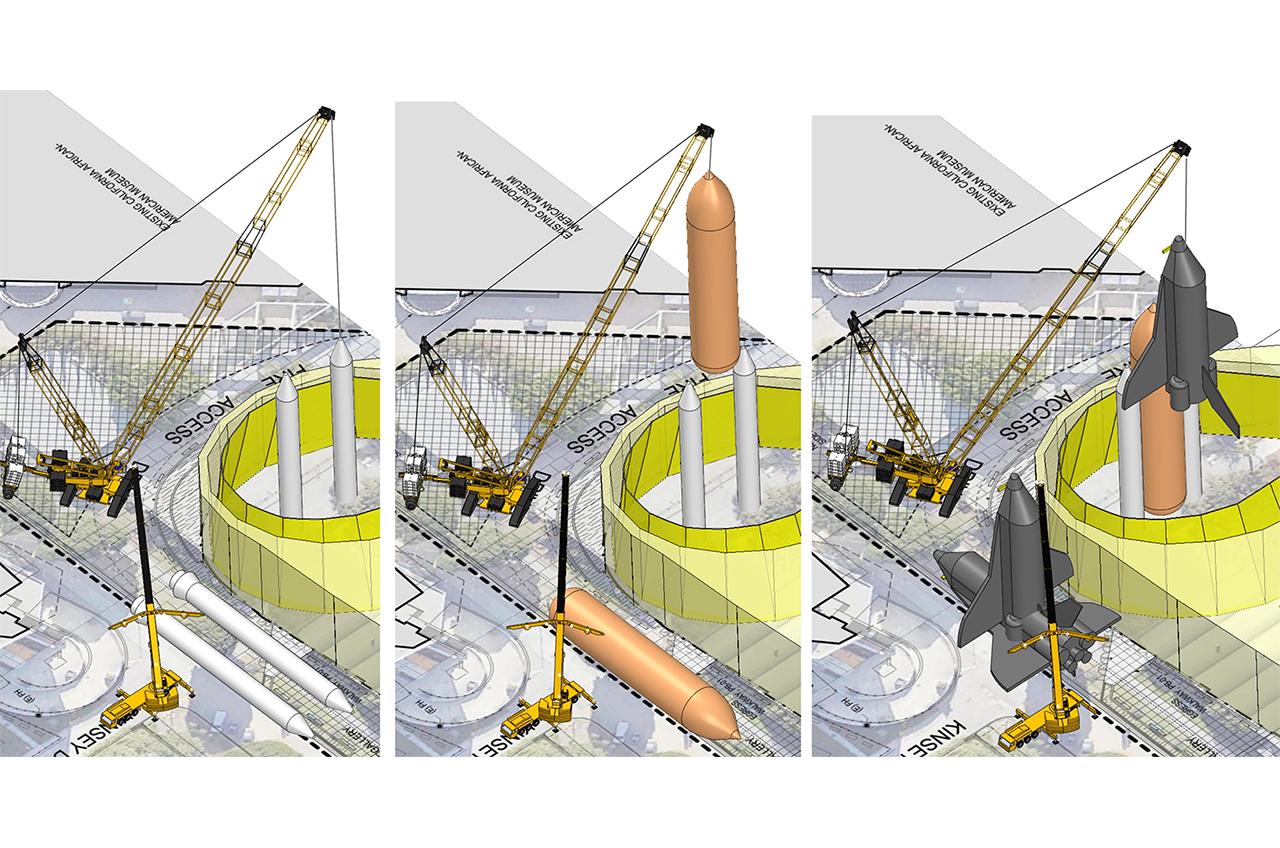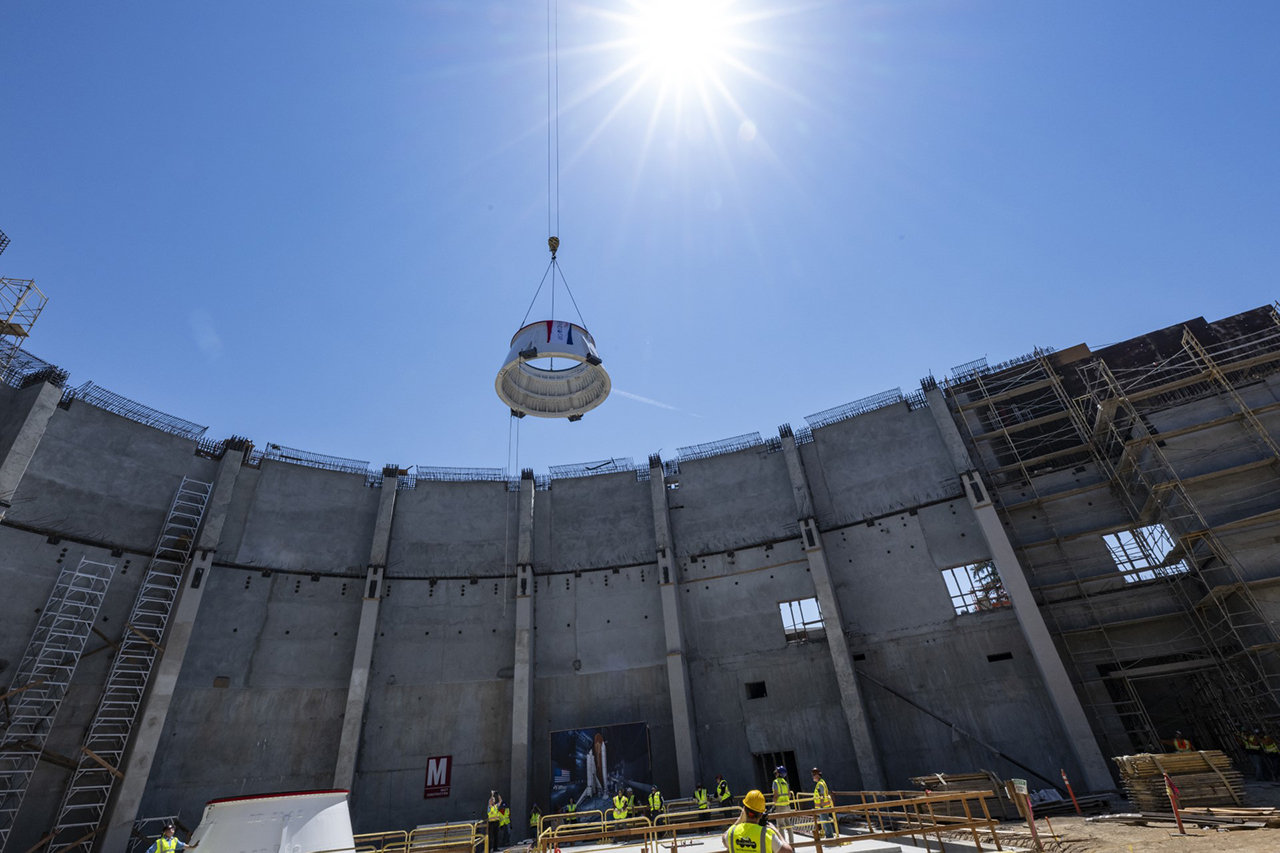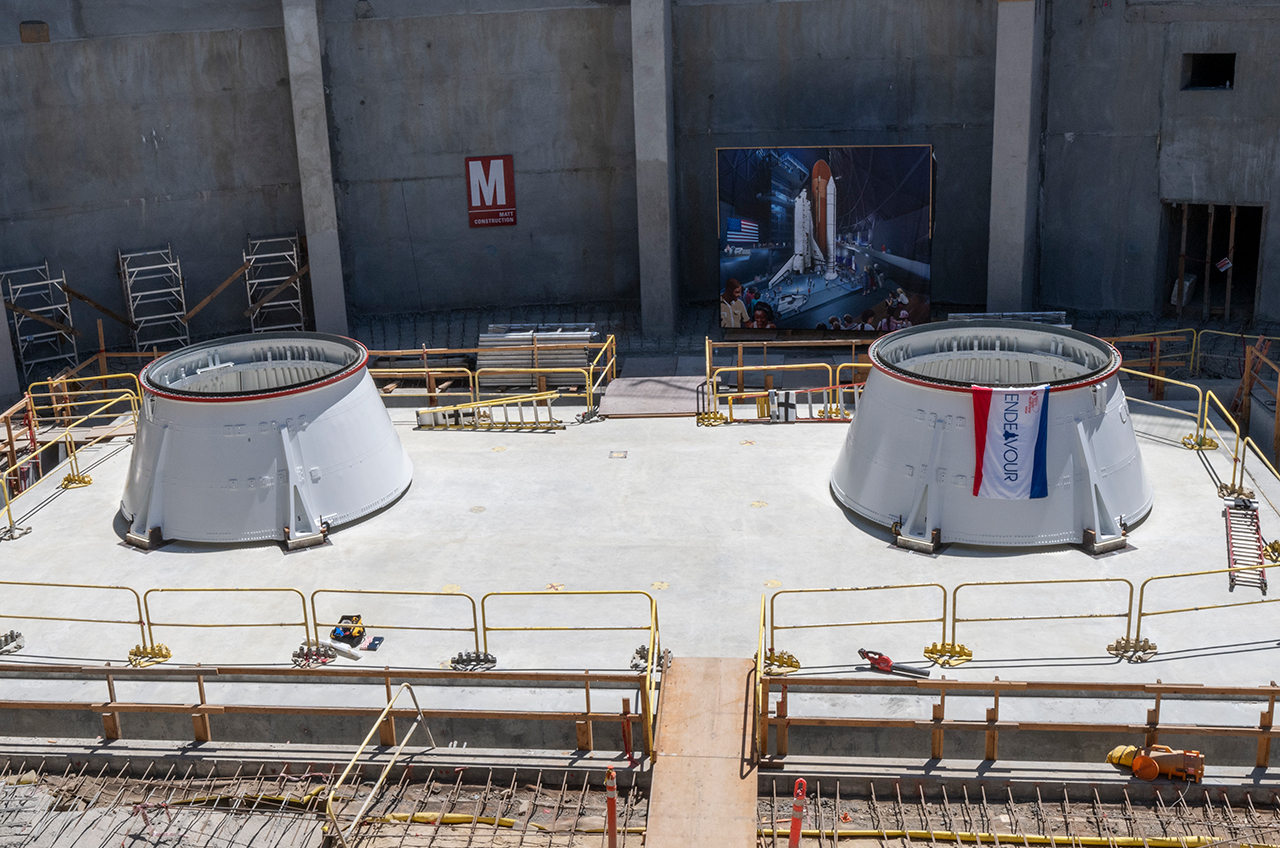'Go for Stack': 1st parts of space shuttle Endeavour vertical display lifted into place at California Science Center
'This is the first step in the six-month process of creating the world's only authentic ready-to-launch space shuttle stack.'

For the first time in 12 years, 3 months and 21 days, the stacking of a NASA space shuttle has begun again.
On Thursday (July 20), the aft skirts for two solid rocket boosters were moved into place. This time though, the preparations were not for a launch into Earth orbit, and it occurred far away from NASA's Vehicle Assembly Building (VAB) in Florida.
Instead, a truck-mounted crane hoisted the 7.5-foot-tall by 18-foot-wide (2.3 by 5.5 meter) aft skirts, one by one, from where they had been parked outside of the California Science Center in Los Angeles into the adjacent construction site where the Samuel Oschin Air and Space Center will stand. Over the next six months, the skirts will serve as a foundation for the rest of the space shuttle to be assembled, concluding with the mating of the winged orbiter Endeavour.
"Today, with the installation of the two aft skirts, we commence 'Go for Stack,' the complex process of moving and lifting each of the space shuttle components into place for Endeavour's upcoming, inspiring 20-story vertical display," said Jeffrey Rudolph, president and chief executive officer of the California Science Center. "This is the first step in the six-month process of creating the world's only authentic ready-to-launch space shuttle stack in the Samuel Ocean Air and Space Center."
Related: Where are NASA's space shuttles now?
The two aft skirts were mounted atop a seismic-isolated 1,800-ton slab of concrete, protecting the future display from being toppled by an earthquake. The moves, which took only a few hours to complete, were relatively simple and straightforward. The real work is what will follow in the weeks to come, as engineers ensure the skirts are level to a difference of 1/16th of an inch or less.
Any more of a variance will propagate higher up the vehicle, to the point that it will prevent the connection of the solid rocket boosters to the external fuel tank.
Once the aft skirts are verified even and their hold down posts are tightened, securing them to concrete slab, the next steps will be to complete the solid rocket boosters. After being trucked in from their storage site at the Mojave Air and Space Port, the twin four-segment boosters will be stacked atop the aft skirts.
During the shuttle program, this was done segment by segment, but given that the boosters will not be filled with propellant, the 116-foot-tall (35 meters) motors will be hoisted as single assemblies, less their 27-foot-long (8 ) forward assemblies, or nosecones, which will stacked separately.
As the boosters are put into place, so will the start of scaffolding that will eventually cover the entire vehicle. The scaffolding is needed to assist attaching the components of the shuttle, as well as protecting Endeavour from damage as construction of the Oschin Air and Space Center continues around and above it.
The external tank (ET-94) has been parked next to the Samuel Oschin Display Pavilion since it arrived at the California Science Center in 2016. The next step will be move the tank over to the construction site and then lift and lower it into place as the backbone of the vehicle. Workers will scale the scaffolding to connect the tank to the two boosters as was done using platforms in the VAB.
As the booster and tank work is underway, Endeavour will remain in its pavilion, open to the public through the last day of the year. It will then go off display to be prepared for the short trip over to the construction site. When ready sometime early next year (a target date has not yet been set), an 825-ton-capacity crane with a 425-foot-long (129.5 m) boom will lift the orbiter using the same sling as was used to hoist it off the modified Boeing 747 Shuttle Carrier Aircraft that delivered Endeavour to Los Angeles in 2012.
Related: Facts about NASA's space shuttle, the 1st reusable spacecraft
"The safe stewardship of this national treasure treasure is our top priority," said Rudolph. "We will take the time necessary to ensure that every step of 'Go for Stack' is completed carefully and correctly, both today and later on in the process. These precautions, paired with potential weather delays, may impact timing, but overall will help ensure the safety of both Endeavour and our team."
Even after Endeavour is in place, the California Science Center expects it to take a few years for the $400 million Samuel Oschin Air and Space Center to be ready to open to the public. In addition to the space shuttle, the new museum will display more than 100 aerospace artifacts, including the forward 50 feet (15 m) of a Boeing 747 commercial airliner and flown Mercury, Gemini and Apollo spacecraft.
"With Endeavour as a centerpiece, the Samuel Oschin Air and Space Center will be one of the world's foremost air and space museums and an unparalleled educational resource. It will take science learning to new heights with 150 hands-on exhibits exploring scientific principles and engineering concepts," said Lynda Oschin, whose family foundation made the lead gift toward Endeavour's exhibit in honor of her late husband.
Prior to being provided by NASA to the California Science Center for use with Endeavour's exhibit, the two aft skirts now installed were used in the launch of 15 space shuttle missions.
The aft skirt at the base of the left solid rocket booster made its first flight in 1982 on STS-3, the third flight of the space shuttle program. The skirt then flew with STS-9, STS-51B, STS-28, STS-37, STS-47, STS-62, STS-74, STS-102, STS-120 and STS-130. (Two of those launches — 47 and 130 — were with Endeavour.)
The skirt standing with the right-side booster first entered service in 1985 with the launch of STS-51G. It then remained on the ground for 16 years before being used again for STS-104, STS-114 (the first return to flight mission after the loss of space shuttle Columbia in 2003) and STS-128.
Breaking space news, the latest updates on rocket launches, skywatching events and more!
Follow collectSPACE.com on Facebook and on Twitter at @collectSPACE. Copyright 2023 collectSPACE.com. All rights reserved.

Robert Pearlman is a space historian, journalist and the founder and editor of collectSPACE.com, a daily news publication and community devoted to space history with a particular focus on how and where space exploration intersects with pop culture. Pearlman is also a contributing writer for Space.com and co-author of "Space Stations: The Art, Science, and Reality of Working in Space” published by Smithsonian Books in 2018.
In 2009, he was inducted into the U.S. Space Camp Hall of Fame in Huntsville, Alabama. In 2021, he was honored by the American Astronautical Society with the Ordway Award for Sustained Excellence in Spaceflight History. In 2023, the National Space Club Florida Committee recognized Pearlman with the Kolcum News and Communications Award for excellence in telling the space story along the Space Coast and throughout the world.





